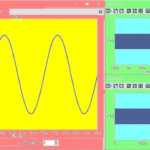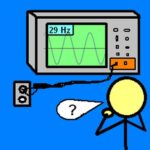In a vacuum or homogeneous medium, the oscillations of magnetic and electric fields are perpendicular to each other and perpendicular to the direction of energy propagation. James Clerk Maxwell concluded that the principle of symmetry should imply that a spatially varying electric field is always associated with a changing magnetic field, and vice versa. In this relationship, neither field “causes” the other. Together, the two fields are the propagating wave. They are situated at right angles to one another, and also at right angles to the electromagnetic wave vector. But they may also be rotating about the line of travel of the electromagnetic wave, and they may exhibit a variety of configurations, such as elliptical polarization.
Interestingly, transverse electromagnetic waves may exhibit polarization, while longitudinal waves such as sound wave propagating through a liquid or gas do not exhibit polarization. But sound waves propagating through solids such as bedrock may exhibit polarization, and this effect is useful in geological exploration.

Circular polarization in particular has interesting properties. In actuality, circular and even linear polarization can be viewed as special cases of the more general elliptical polarization case. To see why, consider what’s called the polarization vector, which decomposes wave polarization into two orthogonal directions, a and b. Further recall that the E field is perpendicular to the direction of propagation, so the polarization vector must also fall within the plane perpendicular to the direction of propagation.
Thus the general equation for a propagating E field can have two components, one for the a direction, the other for the b direction. The E field component in the a direction can have a different amplitude than the E field component in the b direction. Moreover, the amplitudes in the a and b directions can be out of phase. So there can be a phase difference δ between the a and b components of the waves.
You can demonstrate the existence of these components with a light bulb and three polarizers. Suppose you orient two of the polarizers so they completely block all of the light coming from the light bulb–one oriented at 90° to the polarization of the other. Now put the third polarizer in front of the other two but oriented at 45° to their polarization. Surprisingly, more of the light gets through the three-polarizer sandwich than through the first two. Thus the light had a component in the direction of the 45° polarizer.
The equation for an E wave can be written in a way that makes the polarization explicit by including the δ phase difference term between the a and be components. We’ll skip the derivation of this equation because it becomes quite involved. But suffice to say for linear polarization, δ = 0. Circular polarization implies δ= ±90° where right-hand circular polarization has +90° and left-hand circular polarization -90°. Elliptical polarization comprises all other values of δ or where the magnitudes of E in the a and b directions are not the same.

For a circularly polarized wave, the amplitude in the a and b directions must be the same. However, the components of a circularly polarized E field in the a and b directions are 90° out of phase. So if we were to look at the electric field we would actually see it rotating around the axis of propagation.
Now suppose we add two linearly polarized waves together. If they are in phase, they form another linearly polarized wave. But if we add two linearly polarized waves together that are 90° out of phase, we get a circularly polarized wave (if they have the same amplitude). Thus in some scenarios it may be useful to think of polarized waves as comprised of two linear waves that are 90° apart.
The concept of combining two linearly polarized waves leads to the idea of combining two circularly polarized waves. It turns out the combination of two circularly polarized waves yields one linearly polarized wave. A linearly polarized wave can be expressed as the sum of left-hand and right-hand circularly polarized waves. The phase between the two circularly polarized waves determines the resulting linear wave’s polarization tilt.
A point to note about polarization is that different disciplines look at polarization differently: Engineers tend to look at circular polarization from the perspective of the E field source. Thus they assign left-hand and right-hand polarization from the viewpoint of someone standing at the source of the E field. In contrast, optics personnel generally look at polarization from the perspective of a detector, with the E field wave approaching them. So what a an electrical engineer would define as a right-hand circular wave would have a left-hand circular polarization for someone in the optics industry and vice versa.
Circular polarization leads to some interesting phenomenon. For example, consider a pair of circularly polarized glasses as used for creating 3D effects in images. Try looking at yourself in a mirror while wearing them but with one eye closed. Your open eye will be blacked out, the closed eye not. The reason: The handedness of polarized light is reversed when reflected off a surface at normal incidence.
All polarizers have the effective slowing down or diminishing light in one plane. But with circular polarizers there’s an added layer that slows down only one of the planes by a fraction of the wavelength. The truth is all transparent media slow down light to some degree. For example in water it’s only 75% as fast as it is in the air. And in glass it’s even slower.
Thus to create circularly polarized light from linearly polarized light, the usual practice is to introduce a delaying material, called a quarter-wave plate, that slows one component of the linearly polarized light by one quarter of a wavelength.






Leave a Reply
You must be logged in to post a comment.